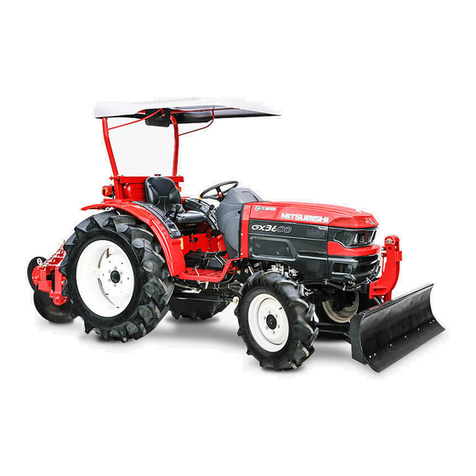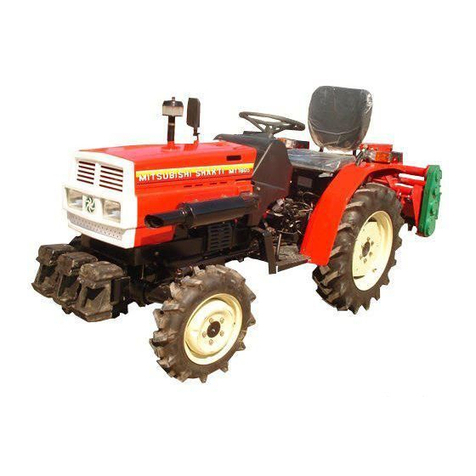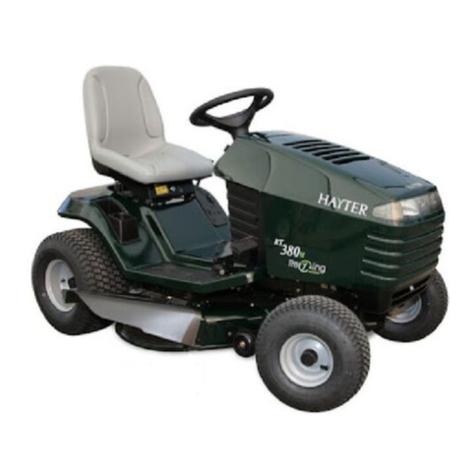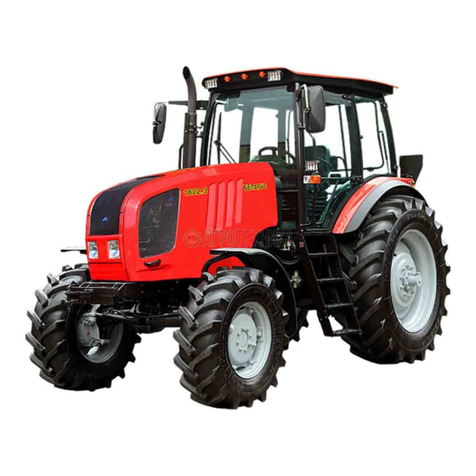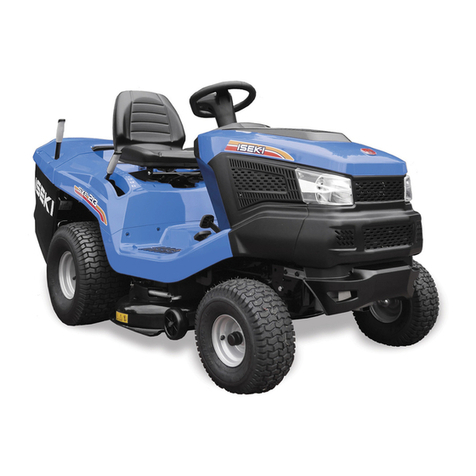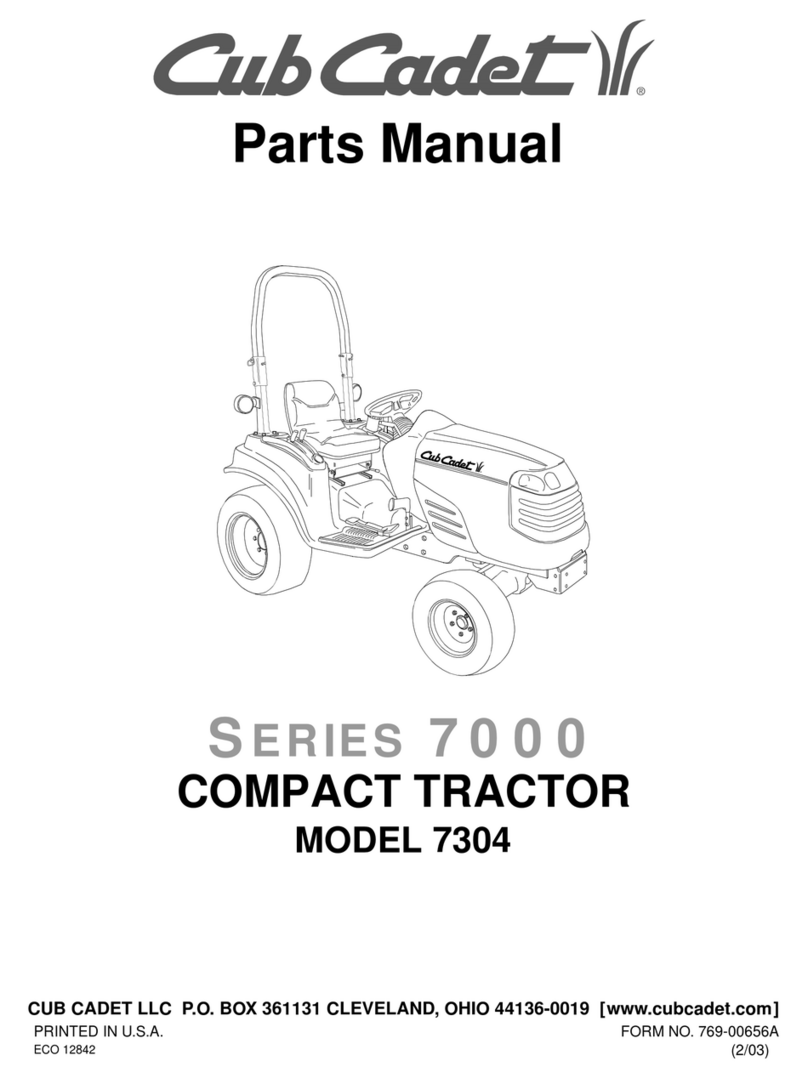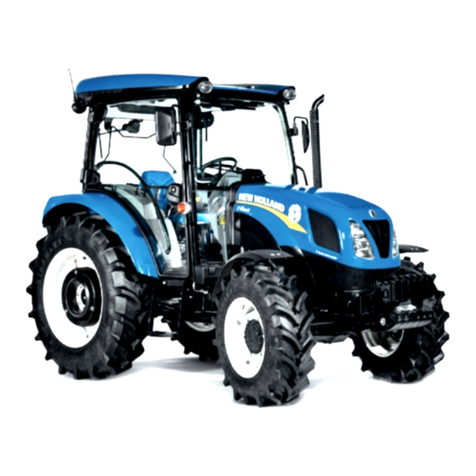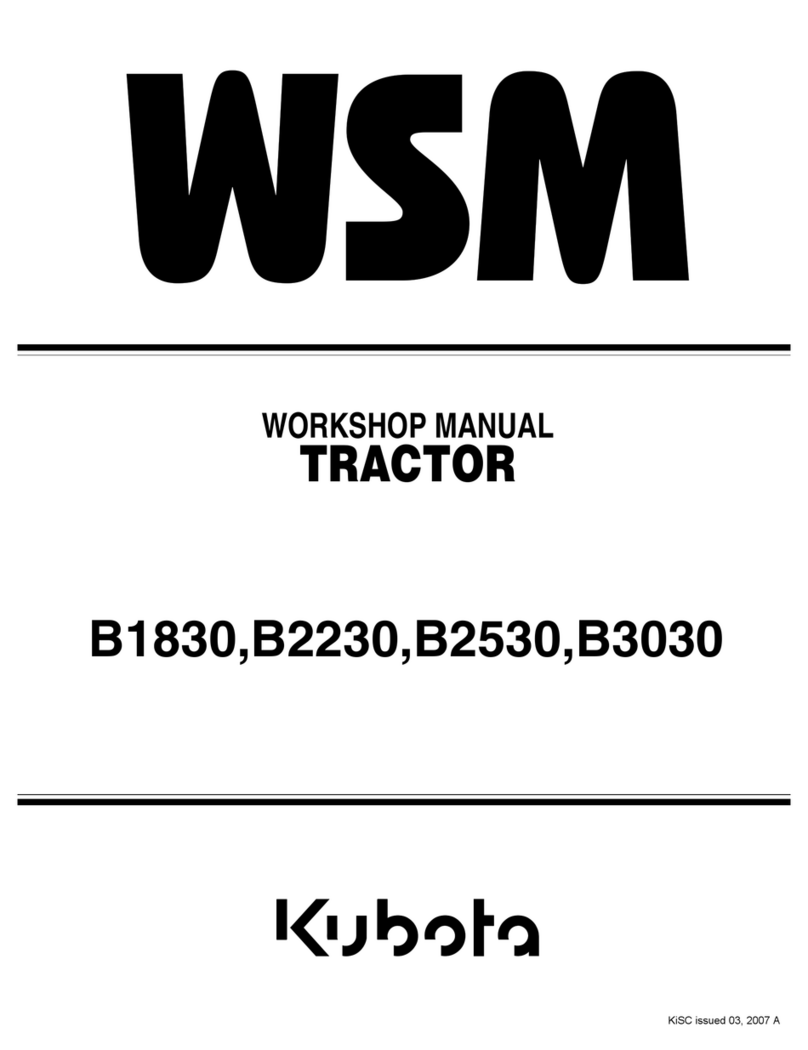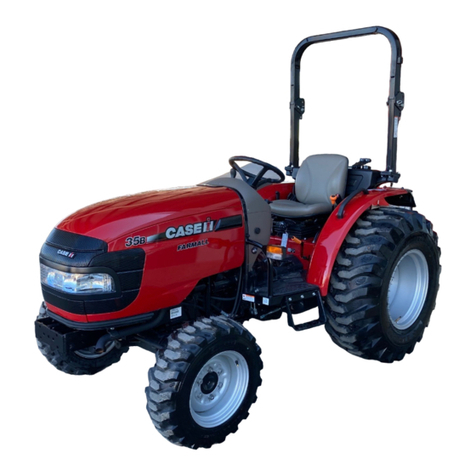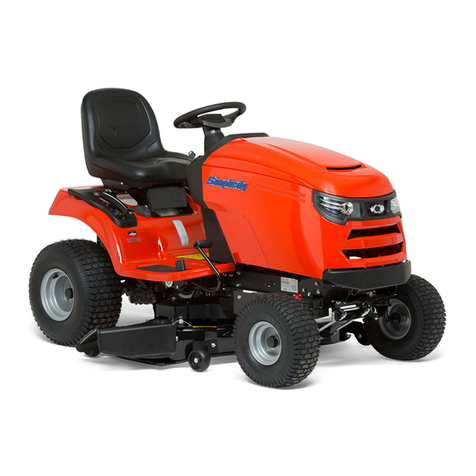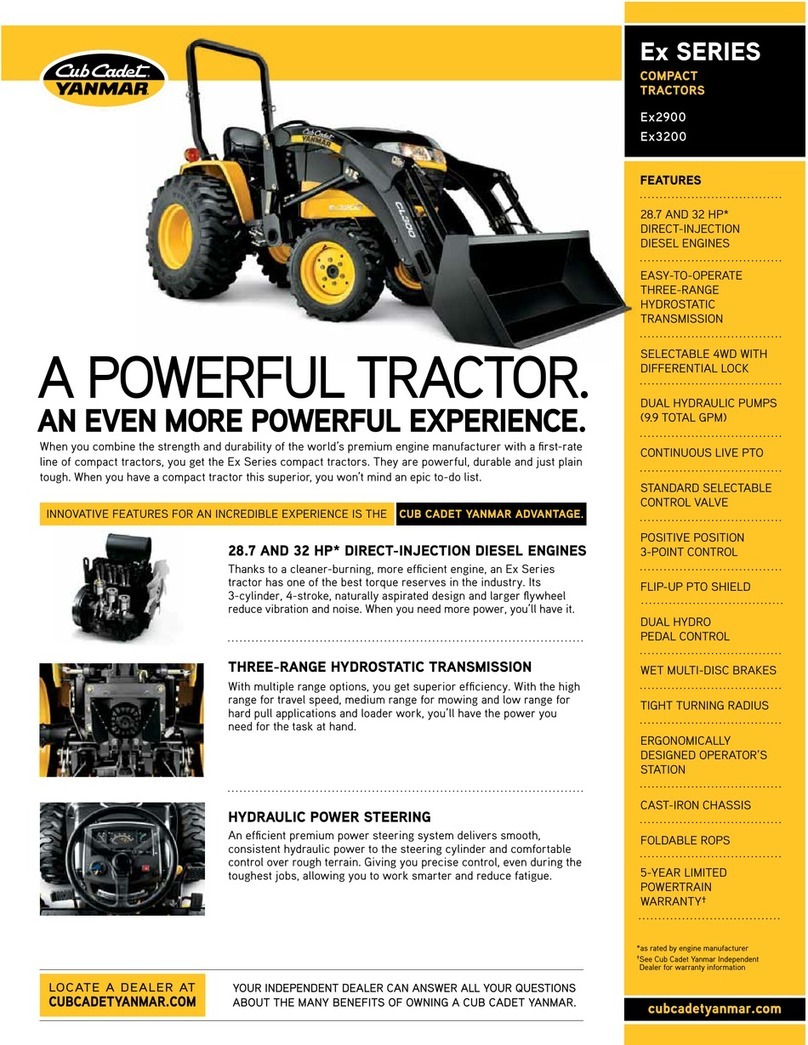Mitsubishi MT160 User manual


----
II

MITSUBISHI
MT160
MT180
MT160D
MT180D
INSTRUCTION BOOK
1..
MITSUBISHI
AGRICULTURAL
MACHINERY
CO.,
LTD.
6-3,
KANDA
KAJICHO 3-CHOME,
CHIYODA-KU,
TOKYO
JAPAN


INTRODUCTION
This instruction manual contains
information
on the operation, lubrication and maintenance
of
your
tractor. The
information
contained
is
comprehensive and essential, and
is
designed
to
assist
you,
even
if
unexperienced, in
utilizing
your
tractor.
How
well
your
tractor
continues
to
give satisfactory performance depends greatly upon the manner in
which
it
is
operated.
It
is, therefore, requested
that
this manual
be
read
carefully and kept ready
for
use
so
that
the operation and maintenance services
will
properly
be
carried
out
in order
to
keep the
tractor
in
top
mechanical
condition
at
all times.
Should any
information
as
to
your
tractor
be
required, consult
your
local dealer
or
distributor
stating
the machine and engine serial
nu
mbers
of
the
tractor
concerned.
We
are
sure you
will
be
happy
with
your
tractor.
NOTE:
Expressions
such
as
LEFT,
RIGHT, FRONT
or
REAR
used
in this manual should
be
understood in
ac-
cordance
with
following
rules:
FRONT means the
front
grill end while REAR means the
lifting
arm end
of
the tractor.
LEFT
or
RIGHT
means the
left
or
right hand side
of
the
tractor
looking forward
from
operator's
seat.
Right
t
Front •
Rear
Left

SERIAL NUMBERS
Tractor
serial number
It
is
located
at
the
right
side
of
the
transmission
case
specifically
upper
side
(under
HST
filter).
NOTES, CAUTIONS and WARNINGS
~".
~----1
:z
Engine serial number
It
is
located
at
the
right
hand
side
of
the
cylinder
block,
specifically injection
pump
side.
NOTES, CAUTIONS and WARNINGS are used
in
this manual
to
emphasize important and critical
instructions. They are used for
the
following conditions:
NOTE .
..............
An
operating procedure, condition, etc., which
is
essential
to
highlight.
A
CAUTION
.
.......
Operating procedures, practices, etc., wh
ich
if
not
strictly observed, will
resu
It
in
damage
to
or destruction
of
machine.
A WARNING .
......
Operating procedures, practices, etc., which
if
not
correctly followed, will
result
in
personal injury
or
loss
of
life.
TREATMENT OF A NEW TRACTOR
All
components
of
your
tractor
are
subject
to
stringent
checking
during assembly
in
the
factory.
However, a
new
tractor
should
be
carefully
checked
over
by
the
operator
himself.
For
the
first-
25
~
50
hours
operation,
heavy
duty
work
should
be avoided. If heavy
duty
work
is
unavoidable,
drive
in
a gear
one
stage lower
than
you
would
normally
use,
and
run
the
engine
at
lower
rpm.
"1M
PORTANT"
50-HOUR SERVICE
,
When
the
tractor
is
brand
new,
after
the
first
50
hours
running,
the
following service,
maintenance
and
checking
should
be
carried
out
by
th
is
instruction
book.
1. Replace
the
engine oil filter
and
engine oil.
2. Replace
the
transmission
oil.
3.
Retighten
all
bolts
and
nuts,
paying special
attention
to
those
for
steering
linkage
and
wheel.
4.
Check
and
adjust
the
fan
belt
tension.
5.
Check
the
wheels
to
see if
their
condition
is
good
and
tire
pressure
is
correct.
6.
Retighten
the
cylinder
head
bolts
and
adjust
valve
clearances.
7.
Front
axle diff. case
and
gear case oil
replacement
of
4-wheel drive
tractor.
8.
Cooling
water
replacement.
9. Air
cleaner
element
cleaning.
10. Clean
the
fuel filter.
11.
Check
the
front
hub
for
end-play.
12.
Check
the
battery
electrolyte.
13. Clean
the
hydraulic
oil filter.
This
50-hour
Service
is
an
essential
procedure
for keeping
the
tractor
in
top
condition,
so
it
must
be
done
properly.

CONTENTS
SECTION
1.
SAFETY
PRECAUTIONS
A.
General Operating Safety Precaution
..........................
'
........
.
B.
Basic
Safety Requirements
for
Maintenance
............................
.
C.
Operation
of
the Tractor. . . . . . . . . . . . . . . . . . . . . . . . . . . . . . . . . . . . . . . . . . . . 2
SECTION
2.
EXTERNAL
VIEW
AND
NOMENCLATURE
OF
EACH
PART
..
6
SECTION
3.
INSTRUMENTS
AND
CONTROLS
...........................
8
Key Start Switch. . . . . . . . . . . . . . . . . . . . . . . . . . . . . . . . . . . . . . . . . . . . . . . . . . .
..
9
Glow Signal
.........................................................
9
Glow Plug
..........................................................
9
Tractor Meter
.......................................................
9
Battery
Charge
Warning Lamp
...........................................
9
Oil
Pressure
Warning Lamp
.............................................
9
Water Temperature Warning Lamp
.......................................
10
Fuel
Meter
..........................................................
10
Light Switch
........................................................
10
Check
Bu
tton
.......................................................
10
Horn Button
........................................................
10
Combination flash and turn
signal
switch
..................................
10
Throttle Lever
.......................................................
10
Clutch
.............................................................
10
Brake
..............................................................
11
Park
ing
Brake
.......................................................
11
Foot
Speed
Control
Pedal
..............................................
11
Power Take
Off
......................................................
11
Differential Lock
.....................................................
12
8-Speed
Transmission
.................................................
13
4-Wh
ee
I Drive
Sh
ift
Lever
..............................................
13
Safety Starter Switch
.................................................
13
SECTION
4.
OPERATION
..............................................
14
Before Operating the Tractor
...........................................
14
St,arting the Engine
...................................................
14
Starting in Cold Weather
...............................................
14
Engine Block Heater
..................................................
14
After
the Engine
is
Started
.............................................
14
Driving the Tractor
...................................................
14
Stopping the Tractor
..................................................
15
Tread Adjustment
....................................................
15
Front
...........................................................
15
Rear
...........................................................
16
Rear
Wheel
Installation
................................................
16
Ballast Weight
.......................................................
16
Tire
Pressure
........................................................
16

r
Operator's Seat
......................................................
17
I
Tool Box
...........................................................
17
Drawbar
...........................................................
17
3-Point Linkage
......................................................
17
Hydraulic System
....................................................
17
Flow
Control Knob
................................................
18
External Hydraulic Service
......................................
'"
.19
Power Take
Off
for
Front
Loader (Option)
..............................
19
P.T.O. Guard
........................................................
19
SECTION
5.
REGULAR
MAINTENANCE
GUiDE
.........................
20
Service Schedu
Ie
.....................................................
20
Service Schedule Chart
................................................
20
Daily Inspection
.....................................................
20
A-Service (Every
50
hours
of
operation)
......
.'
............................
20
50-Hour Service
for
a New Tractor
....................................
21
50-Hour Service
for
Other than New Tractor
............................
21
B-Service (Every 100 hours
of
operation)
..................................
21
C-Service (Every 200 hours
of
operation)
..................................
21
D-Service (Every
400
hours
of
operation)
..................................
21
Maintenance Interval Chart
.............................................
22
Lubrication Table
....................................................
23
Greasing Diagram
....................................................
24
SECTION
6.
PREVENTIVE
SERVICE
INSTRUCTION
.....................
26
Hood and Side Covers Opening/Closing
....................................
26
Checking the Radiator Coolant Level
.....................................
26
Coolant Replacement
.................................................
26
Precautions on Cooling System in Cold Weather
.............................
26
Antifreeze
.......................................................
26
Fuel System
Air
Bleeding
..............................................
27
Fuel
Filter
Air
Bleeding
.............................................
27
Fuel Pump
Air
Bleeding
............................................
27
Fuel Pipe
Air
Bleeding
..............................................
27
Fu.el
Filter
Element Replacement
.....................................
28
Cleaning the Fuel Tank
.............................................
28
Checking the Engine Oil Level.
..........................................
28
Engine Oil Replacement
...............................................
28
Engine Oil Filter Replacement
..........................................
29
Injection Nozzle Inspection
.............................................
29
Cylinder
Head
Bolt
Tightening
..........................................
29
Valve Clearance Adjustment
............................................
30
Valve Clearance Adjustment Procedure
.................................
30

Air
Cleaner
.........................................................
30
Fan
Belt Tension Adjustment
...........................................
31
Battery (Outside
North
America)
........................................
31
Booster Connection
................................................
32
Proper Procedure
for
Booster Connection
...............................
32
Proper Procedure
for
Removing Booster Cable
...........................
32
Proper Battery Service and Tips
for
Safety
..............................
33
Checking the Electrolyte Level
.......................................
34
Battery Recharging
................................................
34
Lubricating the
Tractor
Meter Cable
......................................
34
Transmission Oil Replacement
..........................................
,34
Creaning the Hydraulic Oil Filter
.....................................
35
Checking the 4WD
Front
Axle Oil Level and its Replacement
...................
35
Checking the Oil Level
.............................................
35
Replacing the Oil
of
Front
Axle
......................................
35
Cleaning the Radiator Screen
...........................................
36
Cleaning the Radiator
.................................................
36
Cleaning the Inside
of
Radiator
.......................................
36
Clutch
Pedal
Adjustment
...............................................
36
Brake
Pedal
Adjustment
...............................................
37
Differential Lock
Pedal
Adjustment
......................................
37
Throttle
Lever Adjustment
.............................................
37
Hydraulic Control Adjustment
..........................................
38
Position Control Adjustment
.........................................
38
Hydraulic Pump Relief Valve
...........................................
38
AC Generator
.......................................................
38
Starting
Motor
.......................................................
39
Regu
lator
..........................................................
39
Glow
Plug
......................
,
...................................
39
Fuse
..............................................................
39
SECTION
7.
STORING
................................................
.40
Storage
............................................................
40
. Reoperation
After
Storage
.............................................
40
SECTION 8.
WIRING
DIAGRAM
........................................
.41
SECTION 9. SPECIFICATIONS
AND
DATA
................................
42
Engine
.............................................................
42
Cooling System
......................................................
42
Fuel System
........................................................
42
Lu
brication System
..................................................
.42
Air
Cleaner
.........................................................
42
Governor
...........................................................
42
Electrical System
.....................................................
42
Chassis
Dimensions
...................................................
43

Clutch
..............................................
"
.............
43
Transmission
........................................................
43
Power Take
Off
......................................................
43
Brake
..............................................................
43
Steering
............................................................
43
Hydraulic System
....................................................
44
3-Point Linkage
......................................................
44
Drawbar
...........................................................
44
Tire
...............................................................
44
Travelling
Speed
.....................................................
45
Capacities
..........................................................
45

SECTION 1.
SAFETY
PRECAUTIONS
REMEMBER:
"SAFETY"
IS
ONLY
A WORD
UNTIL
IT
IS
PUT INTO PRACTICE
Improper
handling
of
the
tractor
could
lead
to
an
accident.
Prior
to
the
operation
of
the
tractor,
be
sure
to
read this
Manual
carefully
and
have a
thorough
understanding
of
all
of
the
contents.
In particular,
the
instructions
given
in
this
section
entitled
"Safety
Precautions"
must
be
strictly
followed.
A. GENERAL OPERATING SAFETY PRECAUTION
A 1. Observe all
the
safety
precautions
in
this
manual
3.
4.
when
operating
the
tractor.
Operate
the
tractor
while wearing
tight
clothing
that
allows easy
movement.
Avoid loose
jackets,
mufflers,
ties, scarves,
or
loose sh irt sleeves
to
prevent
from
being
caught
by
moving
parts.
Always
work
when
you
are
in
good
physical
condi-
tion
by
taking
sufficient
rest
to
avoid
overwork.
Do n'ot
allow
children
or
adults
having
no
knowl-
edge
of
the
tractor
or
tractor
operation,
to
operate
the
tractor.
Never allow riders
on
the
tractor,
linkage
drawbar
or
attachments
while travelling
and
operating
them.
B.
BASIC SAFETY REQUIREMENTS FOR
MAIN-
TENANCE
Always
follow
these
maintenance
instructions
before
operating
the
tractor:
1.
Immediately
repair
the
head
lights
and
work
lamps
required
to
conform
to
traffic
regulations
where
the
tractor
is
operated.
-1-
2. Keep
tractor
steps
clean
to
avoid
accidents
due
to
slippage.
Cover
the
PTO
shaft
with
a
guard
when
not
using.
Be
sure
to
apply
the
brake
and
lower
any
attach-
ment
or
implement
before
disassembling
any
part.
Never
adjust
or
service
the
tractor
when
it
is
in
motion
or
while
the
engine
is
running.
Always
adjust
the
brake
or
clutch
properly
in
accordance
with
the
adjusting
procedure
in
the
instruction
book.
Do
not
remove
the
radiator
cap
while
the
engine
is
running.
Shut
down
the
engine
and
wait
until
it
cools
sufficiently.
For
removal,
turn
the
cap
to
the
first
stop
to
relieve
pressure.
To
replace
the
coolant,
use
the
coolant
recovery
tank.
A7.
Hydraulic
oil
or
fuel escaping
under
pressure can
penetrate
the
skin,
causing serious
injury.
Before
disconnecting
oil
or
fuel lines, be sure
to
relieve all
pressure.
Before restoring pressure
after
repair,
be
sure
all
connections
are
tight
and
all
hydraulic
components
are
in
normal
condition.
If
injured
by leaked
fluid,
see a
doctor
immedi-
ately
for
proper
treatment.
8.
When refueling, be
particulary
careful
first
to
stop
the
engine
completely
to
prevent
the
fuel
from
igniting. Never refuel in
the
presence
of
an
open
flame
or
while
smoking.
Always
use
funnel
when
adding
fuel
and
refuel
only
out
of
doors.
When
refueling
is
completed,
wipe
any
spilled fuel
off
the
tractor
and
securely
fasten
the
cap
of
the
fuel
tank.

9.
Before
starting
any
work
on
electrical
equipment
or
work
that
may
cause
you
to
touch
the
electrical
part
accidentally,
first
disconnect
the
battery
cables.
Never remove
the
ru
bber
cap
cover
at
the
positive
terminal
of
the
battery
cable
end.
Before
connecting
the
battery
to
the
charger,
make
sure
that
the
charger
switch
is
in
"OF'F"
position.
Be
sure
to
connect
the
charger
to
the
correct
term
inals
on
the
battery,
(positive
to
positive, negative
to
negative).
A
great
amount
of
hydrogen
gas
is
generated
by
the
battery
when
it
is
being
charged.
Take
precau-
tions
against
fire:
do
not
have
any
exposed
flame
in
the
area
where
you
are
working.
Be
sure
not
to
cause
any
leakage
of
the
electrolyte,
since it will
corrode
the
skin
or
clothing.
In case
of
accident
as
described
below,
immediately
seek
first
aid,
and
see a
doctor
immediately
for
proper
treatment.
a) If
the
diluted
sulphuric
acid
from
the
battery
has
gotten
into
the
eyes:
Cleanse
the
eyes
with
a
lot
of
clean
running
water
for
more
than
15
minutes,
while
opening
the
eyes
widely.
b)
If
diluted
sulphuric
acid
from
the
battery
has
been
swallowed:
Rinse
the
mouth
with
clean
water
immediately
and
drink
a
lot
of
raw eggs
or
milk.
Lie
down
quietly.
c)
If
diluted
sulphuric
acid has
gotten
on
the
skin
or
clothing:
Wash
away
the
diluted
sulphuric
acid
com-
pletely
with
a
lot
of
clean
running
water
and
neutralize
with
soap
solution.
Then
rinse
with
water.
d)
If
the
diluted
sulphuric
acid
is
spilled:
Wash
away
with
a
lot
of
water
or
neutralize
with
slacked Iime
or
bicarbonate
of
soda.
A
10.
Stop
the
engine
and
make
sure
the
PTO
shift
lever
is
in
Neutral
before
performing
any
of
the
follow-
ing services, including:
a)
Removal
of
the
propeller
shaft
between
PTO
and any
attachment,
b)
Adjustment
of
PTO drive
train
and
hitch.
c)
Adjustment
or
cleaning
of
PTO
driven
attach-
ment.
11.
The
steering
wheel always has built-in
play
to
some
extent,
which
is
required
for
smooth
mesh-
ing
of
sector
gear
and
pinion
gear.
Always
inspect
the
amount
of
the
play.
Do
not
operate
the
tractor
if
there
is
too
much
or
too
little
play
in
the
steering.
C.
OPERATION
OF
THE
TRACTOR
Before
driving
the
tracotr,
follow
these
rules:
C-1
Before
Starting
and
Driving
the
Tractor
A
Operate
the
tractor
only
when
seated
properly
in
operator's
seat
and
keep
a firm grip
on
the
steering
wheel
at
all
times.
Never
attempt
to
perform
any
operation
of
the
tractor
from
anywhere
else,
on
or
off
th
e
tracto
r.
Always
wear
a
"hard
hat"
when
operating
the
tractor.
C-2
Starting
and
Driving
the
Tractor
-2
--
Always
operate
the
tractor
at
the
proper
speed
which
enables
you
to
keep
the
tractor
under
your
complete
control.

I
To
start
travelling, lower
the
engine speed and release
the
clutch pedal slowly.
Abrupt
releasing causes
the
tractor
to
jump
off.
Before leaving
the
tractor,
stop
the
engine, remove
the
key,
apply
the
parking brake
and
make
sure
that
the
engine has
come
to
a
complete
stop,
and
any
attach-
ment
is
completely
touching
the
ground.
A Slow
down
when
operating
the
tractor
on rough
round.
A Never
attempt
to
jump
on
or
off
a moving
tractor.
A When starting
the
tractor,
operating
any
attachment
or
engaging
the
PTO make sure
that
no
one
is
in
the
way,
especially children.
AWhen
starting
the
engine
in
an enclosed area
or
build-
ing, ensure
proper
ventilation
by
opening
the
doors
and/or
windows
to
prevent
carbon
monoxide
inhala-
tion.
Mount
the
extension
exhaust
pipe on
the
tractor
which has a cabin.
-r,,)j/
f,")
)
-3-

A If
the
tractor
is
equipped
with
ROPS fasten
the
seat
belt before using
the
tractor
and
keep it
fastened
while
in
operation.
A Use
of
the
seat belt
is
not
recommended
for
·tractor
without
ROPS.
C-3 Travelling
on
Roads
and
Streets
A
For
travelling
on
roads
and
streets
be sure
to
lock
both
brake
pedals
together
before
driving
to
prevent
either
brake
from
acting
independently.
-4-
A Never
operate
the
differentiallock
speed
or
travelling
on
the
road.
For
drilling
the
4-WD
tractor
on
the
road,
be sure
to
place
the
4-WD
shift
lever in
OFF
position.
C4
Steering
and
Turning
the
Tractor
A
Slow
down
your
tractor
and
disengage
the
differential
lock
before
going
into
a
turn,
being careful
to
prevent
any
attachment
mounted
on
the
front
or
rear
from
hitting
anyone
or
anything.
C-5
Towing
and
Operating
on
Hills
A
For
towing
work
on
downward
slope, place
the
shift
lever
in
low speed
and
use engine
brake.
Never
try
to
reduce
the
speed
with
brake
only.
A
Towing
a heavy
object
on a hill
is
highly
hazardous.
Widen
the
tread
of
the
tractor
and
mount
the
wheel
weight
or
chassis
weight
to
increase
the
stability
and
operate
with
extra
caution.
A When
operating
the
tractor
on
eigher a
steep
slope
or
flat
ground,
be sure
not
to
suddenly
steer,
brake
or
operate
clutch
or
attachments.
A Do
not
operate
the
tractor
at
the
edge
of
cliff
or
steep
slope.
Be
particularly
careful right
after
the
rain
when
soil
is
soft
and
may
give
way
easily.
/
l
•

For
towing,
be su
re
to
use
the
drawbar
only.
Set
the
hitch
point
below
the
center
line
of
the
rear axle.
When
using a
chain,
never
try
to
move
forward
abruptly.
When using a long
chain
or
cable
to
hitch
the
tractor
to
the
load, drive-the
tractor
forward
slowly
until all slack
is
taken
out.
Avoid
operating
the
tractor
on
an
extreme
slope
that
appears
hazardous,
when
forced
to
operate
on
such
slope,
use
extra
care.
Driving
forward
out
of
a
ditch
or
mired
condition
or
up
a
steep
slope
could
cause
tractor
to
tip
over rear·
ward.
Back
out
of
such
situation
if
possible. If
the
situation
does
not
permit
you
to
back
out,
use
the
front
wheel
weight
or
the
chassis
weight
for
balancing
the
tractor
lengthwise.
Also
in
case
any
extra-heavy
rear
mounting
attachment
is
used,
try
to
obtain
better
balance
in
this
manner.
When
backing
down
a
slope
in
reverse gear
or
going
up
the
grade
in
forward
gear, never
operate
the
clutch,
brake,
th
rottle
lever
or
steering
wheel
abruptly.
Be
particularly
careful
on
slippery
roads.
A
In
any
case
of
towing
(by
use
of
a
rope
or
by
hanging
up
the
front),
be
sure
to
place
the
both
main
shift
lever
and
sub
shift
lever
at
"NEUTRAL"
position
50
long as
the
rear
wheels
are
on
the
ground.
*
These
shift
levers shall
not
be
placed
at
any
other
speed
range.
AWhen
starting
the
engine
by
towing
the
tractor
with
a
battery
as
discharged,
be sure
to
place
the
main
shift
lever
at
the
3rd
speed
step
and
the
sub
shift
lever
at
the
high
speed
step,
then
operate
the
clutch
slowly.
/).
* Never place
the
sub
shift
lever
at
the
low
speed
step.
~
When
towing
the
tractor,
be
sure
to
keep
the
safety
speed.
It
is
advisable
to
operate
at
10
km/h
(6.3
mph)
or
less
in
towing
the
tractor
under
20 HP
and
at
20
km/h
(12.4
mph)
or
less
in
towing
the
tractor
over
20 HP.
A When
towing
or
running
on
a
steep
downward
slope, be
sure
to
apply
the
engine
brake
to
keep
safety
speed.
Never
run
by
inertia (coasting)
with
main
shift
lever placed
"NEUTRAL"
position
or
the
clutch
disengaged.
C-6 Using
Attachment
To
mount
or
operate
attachments,
follow
the
instruc-
tion
manual
for
the
particular
attachment
for
safe
operation.
A
When
using agricultural
chemicals
with
an
attachment
on
the
tractor,
always
follow
the
instructions
in
the
manual
for
the
attachment
as well as
the
instructions
provided
by
the
chemical
manufacturer.
C-7
Roll Over
Portective
Structure
(ROPS)
Strongly
recommends
a ROPS
(RollOver
Protective
Structure)
install
to
your
tractor.
A ROPS
frame
is
available
for
these
tractor.
Tractors
can
be rolled over.
A Always
tighten
the
bolts
for
ROPS
mounting
securely.
Exercise
good
care
in
seat
belt
installation
as regard
belt
strength
and
the
bucket,
which
must
not
be
broken
off
or
disconnected.
For
further
details, ask
your
delaer.
-5-

j 3
SECTION 2.
EXTERNAL
VIEW
AND
NOMENCLATURE
OF EACH
PART
9 6
54
2 3
7 8
1.
Steering
wheel
2.
Fuel
tank
cap
3.
Head lights
4.
Throttle
lever f
5.
Main
shift
lever
6.
Combination
flash
and
turn
signal lights
7.
MT180/D
...
Position
control
lever
MT160/D
...
Lift,
hold,
down
control
lever
8.
Seat
9.
Fenders
10.
Brake pedals
11.
Foot
speed
control
pedal
12.
High-Low
shift
lever
13.
4wheel
drive
shift
lever
14. 4WD
AG
front
tire
15.
AG
rear
tire
16.
Bumper
14
16
2
1.
Bonnet
2.
Muffler
3.
Front
drive diff. gear case
4.
Drag link
5.
Clutch
pedal
6.
P.T.D.
shift
lever
7.
Arm rest
8.
Red rear light
3 4 5 6 7 8
The
above
photoes
show
MT180D
(4-WD).
-6-

-
2 3 4 5 6
8
2 4 5 6 7
For
opening
the
bonnet,
remove
backward
the
hook
on
the
rear
side
of
the
bonnet.
When closing
the
bonnet,
be
sure
to
confirm
the
bonnet
is
secured.
-7-
7
1.
Battery
2.
Radiator
cap
3.
Cyclone
type
ai
r
cleaner
4. Air
cleaner
dust
pan
5.
Engine oil filler
cap
6.
Tachometer
cable
7. Fuel
tank
cap
8.
Alternator
1. Engine oil level gauge
2.
Injection nozzle
3.
Solenoid
for
key
engine
stop
4.
Fuel
injection
pump
5.
Lead wire
for
water
temp.
warning
lamp
6.
Air
cleaner
hose
7.
Radiator
hose

SECTION
3.
INSTRUMENTS
AND
CONTROLS
2 3 4 5 6 7
2 3 4
-8-
1. Fuel meter
2.
Check
botton
3.
Monitoring
lamp
unit
(L.H.)
4.
Horn
switch
5.
Light
switch
6.
Combination
flash and
turn
signal switch
7.
Fuse
box
1.
Glow
signal
2.
Key start switch
3.
Monitoring
lamp
unit
(R.H.)
4.
Tractor
meter
5.
Throttle
lever
-..,.....-
I
I
I
i
..

•
KEY
SART
SWITCH
(Engine
on-off
key
switch)
Heat
position
.........
Power
applied
to
the
glow
plug
OFF
position
.........
Engine
and
all lights
turned
off
ON
position
..........
Engine
running
and
electrical
circuit
energized.
START
position
.......
Starts
the
engine
then
key
returns
to
"ON"
position.
ACAUTION
Be
sure
to
remove
key
whenever
tractor
is
not
in
operation.
GLOW
SIGNAL
When
the
starter
key
is
turned
to
"HEAT"
position,
inter-
nal coil glows in
red
indicating
that
the
engine
is
preheated.
The
engine
will be
preheated
in 5
sec.
under
normal
tem-
perature.
GLOW
PLUG
The
engine
is
fitted
with
speed
heating
sheathed
glow plug
which
preheat
the
combustion
chamber
so
that
the
engine
may
be
started
easily even
in
cold
weather.
-9-
TRACTOR
METER
The
tractor
meter
indicates
engine
rpm.
Indication
of
Meter
P.T.O.
shift
rotation
2,340
at
P.T.O.
1st
shift
540
rpm
1,793
at
P.T.O.
3rd
shift
1,000
rpm
BATTERY
CHARGE
WARNING
LAMP
[In
the
monitoring
lamp
unit
(L.H.)]
When
the
starter
switch
is
set
to
"ON",
this
lamp
lights
up.
When
the
battery
is
being
charged
normally
wh i
Ie
the
engine
is
running
the
lamp
should
go
off.
If
the
lamp
continues
to
light,
stop
the
engine
immediately
and
see
your
Mitsubishi
dealer.
OIL
PRESSURE
WARNING
LAMP
[In
the
monitoring
lamp
unit
(L.H.)]
When
the
starter
key
is
switched
"ON",
this
lamp
lights
up.
When oil
is
circulating
normally
while
the
engine
is
running,
the
lamp
turns
off.
If
the
lamp
still lights
up
after
the
engine
has
been
started,
stop
the
engine
immediately
and
check
the
engine
lubrication
oil level. If
that
is
OK,
see
your
Mitsubishi
dealer.

WATER
TEMPERATURE
WARNING
LAMP
[In
the
monitoring
lamp
unit
(R.H.)]
When
the
temperature
of
the
cooling
water
exceeds
110°C
(230°F),
the
water
temperature
warning
lamp
lights
up.
When
this
occurs,
lower
the
engine
speed
to
about
900
rpm
immediately
and
wait
until
the
warning
lamp
goes
off.
Then
stop
the
engine
and
check
the
amount
of
cooling
water,
the
fan
belt
tension,
the
wiring,
the
temperature
gauge
unit
and
the
lamp
bulb.
AWARNING
Be
especially
careful
of
the
removal
of
the
radiator
cap.
FUEL
METER
Indicates
remaining
fuel.
When
the
pointer
comes
over
the
"E"
position,
fill fuel as
soon
as possible.
LIGHT
SWITCH
The
head
light
switch
is
installed
on
instrument
panel
and
the
operation
is
accomplished
by
turning
the
switch
lever
clockwise.
OFF.
.............
Lights
are
off.
. . . . . . . . . . . . .Red tail light
and
meter
panel
lights are
on
.
§o·········
. . .
Headlight
are
dimmed
and
direct-
ed
downwards
......
low
beam
~O
..............
Bright
head
lights
....
high
beam
CHECK
BUTTON
Turn
the
key
switch
"ON"
and
push
the
check
button
with
the
engine
kept
stopped.
Then,
all
the
warning
lamps are
lighted
except
the
turn
signal lamps.
If
not,
ask
the
dealer
for
check.
HORN
BUTTON
Horn
is
effective
while
key
start
switch
is
in
"ON"
posi-
tion.
If
not,
ask
the
dealer
for
check.
COMBINATION
FLASH
AND
TURN
SIGNAL
SWITCH
Two
flashing lights are
located
on
the
rear
of
the
fenders.
Anytime
the
tractor
is
operated
on
pUblic
roads,
the
flashing lights
should
be
used.
The
flasher
switch
is
installed
on
instrument
panel
and
it
is
used
when
making
a
tu
rn
to
right
or
left.
Turning
the
switch
leftwise causes
to
flash
the
left-hand-
side
turn
signal,
and
turning
it
rightwise
causes
to
flash
the
right-hand-side
turn
signal,
respectively.
Also,
pulling
the
switch
upward
places
the
turn
signals
at
both
sides
into
the
flashing
condition.
Turning
the
switch
in
this
condition
leftwise
causes
the
left·hand-side
turn
signal
to
repeat
flashing
and
the
right-
hand-side
turn
signal
to
be
placed
in
the
lighted
condition,
while
turning
it rightwise causes
to
occur
the
condition
just
reverse
to
the
above.
THROTTLE
LEVER
When
the
throttle
lever
is
pushed
forward,
the
engine
speed
reaches
the
maximum.
The
speed
range
controlled
by
the
lever
is
900
to
2,900
rpm
(with
no
load).
When
the
P.T.O.
gear
is
shifted
to
"1
st"
at
2,700
rpm
(rated
engine
rpm),
the
P.T.O.
shaft
rotates
at
623
rpm .
CLUTCH
-10
-
Other manuals for MT160
1
This manual suits for next models
3
Table of contents
Other Mitsubishi Tractor manuals

